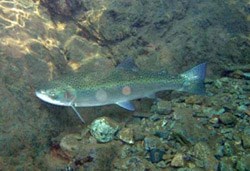
Steelhead - Oncorhynchus mykiss Identification: 
Spawning: Summer runs have extensive ranges, swimming to the far reaches of the Hoh, Quinault, and Queets Rivers, and historically, the Elwha River. Both summer and winter-run steelheads spawn in the spring. Summer-runs migrate to freshwater before their reproductive organs are fully developed, while winter-run steelhead do all their maturing at sea. Steelhead redds can be seen near the Hoh, Sol Duc, and Queets campgrounds during May and June. Conservation Status: Due to the presence of the tribal hatchery, the Elwha River is the largest producer of steelhead in the Strait of Juan de Fuca. Wild production of steelhead, however, is limited by available freshwater habitat. Removal of the dams in the Elwha River may allow steelhead to recover to historic numbers. (Historic Range Map)
|
Last updated: February 28, 2015

